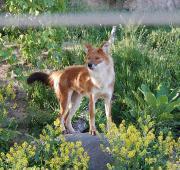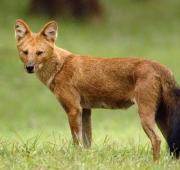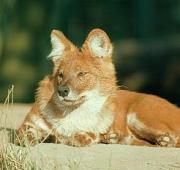 The dhole (also known as the Asiatic Wild Dog, Indian Wild Dog and the Red Dog) is an endangered wild dog native to the jungles of Asia. Although the dhole is very similar in appearance to the African Wild dog and the Bush dog, the dhole is the only member of it's genus.
The dhole (also known as the Asiatic Wild Dog, Indian Wild Dog and the Red Dog) is an endangered wild dog native to the jungles of Asia. Although the dhole is very similar in appearance to the African Wild dog and the Bush dog, the dhole is the only member of it's genus. Historically, the dhole was found though East and Southern Asia, from the Russian far east right down to Sumatra, and although today the range of the dhole has been significantly reduced, the dhole inhabits a wide variety of habitats including thick, deciduous woodlands to jungles and tropical rainforests.
Historically, the dhole was found though East and Southern Asia, from the Russian far east right down to Sumatra, and although today the range of the dhole has been significantly reduced, the dhole inhabits a wide variety of habitats including thick, deciduous woodlands to jungles and tropical rainforests.


The dhole is a carnivorous and fairly dominant predator within it's natural environment, working as part of a pack to try and bring down larger prey to feed the whole group. The majority of the dhole's diet however is made of smaller animals including lizards, frogs and rodents.
Due to the dominant nature of the dhole and the fact that it often has protection from it's pack, there are few animals that are of any threat to the dhole in the wild. Large wild cats such as tigers and leopards are the only natural predators of the dhole, as the biggest threat to the world's dhole populations has been from humans.
After breeding, female dholes give birth to between 5 and 12 pups after a two month long gestation period. Dhole pups grow rapidly and are cared for by both their parents, and by other adult dholes in the pack. The dhole pups begin to hunt when they are a few months old and reach adult size by the time they are about a year and a half old.
Today, the dhole is endangered in the wild as populations have been reduced to less than 2,000 individuals across their native territories. The main reason for the severe decline in the dhole population numbers is thought to be through habitat loss and hunting from humans.

